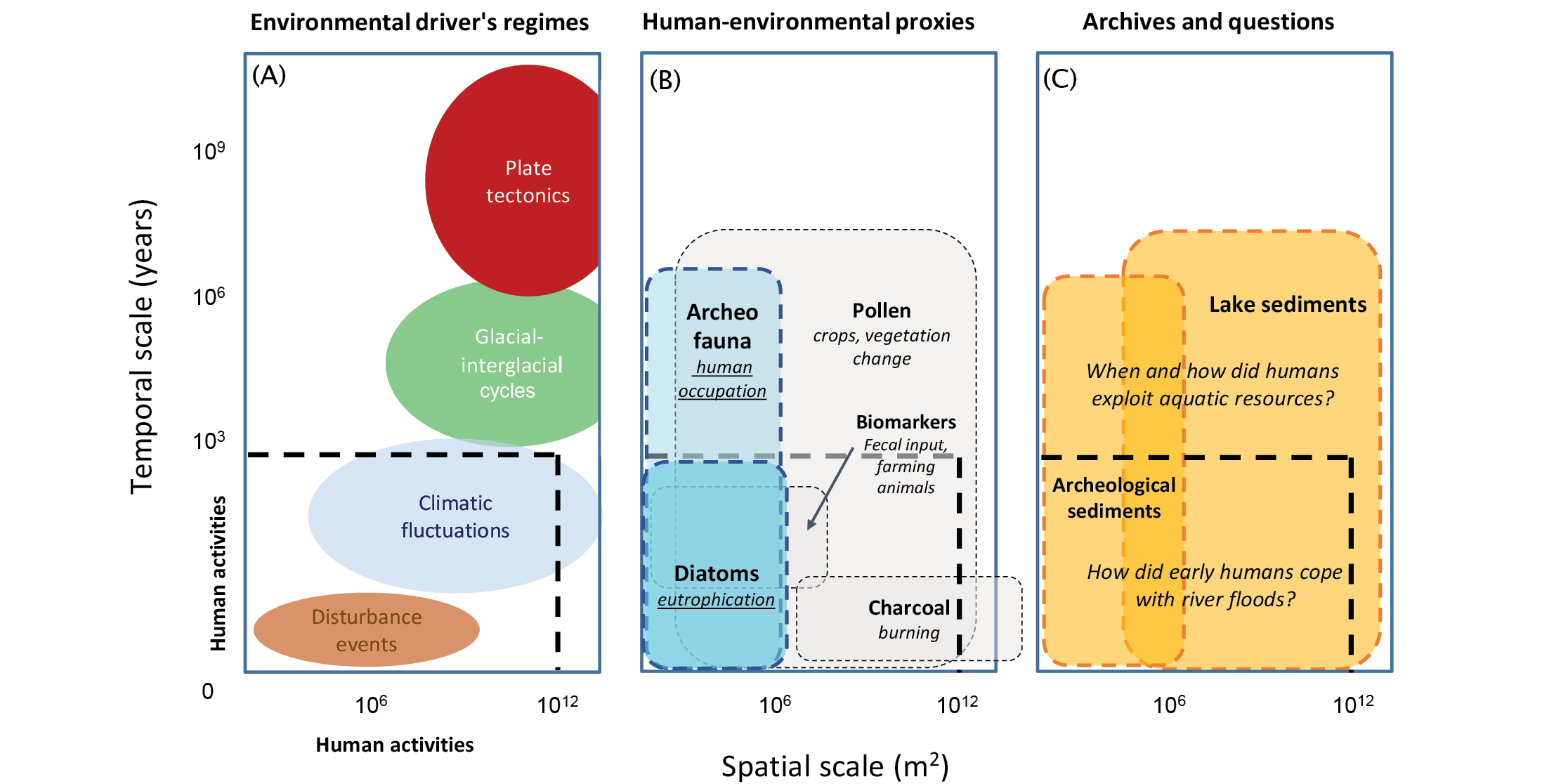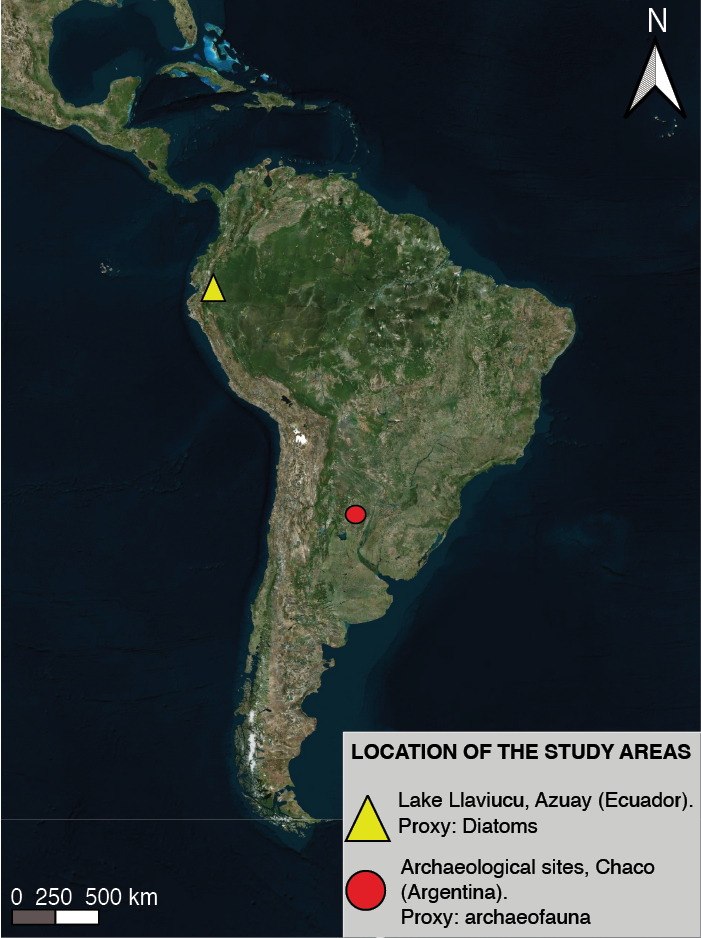- Home
- Publications
- PAGES Magazine
- Integration of Proxies In Human–environmental Systems: Paleoecology, Paleoclimatology, and Archaeology
Integration of proxies in human–environmental systems: Paleoecology, paleoclimatology, and archaeology
Macarena M. Zarza, X. Benito, C. Flores, S.K. Mandal, A. Maldonado and S.Y. Maezumi
Past Global Changes Magazine
31(1)
8-9
2023
Co-developing paleoscience research questions is associated with effective collaboration challenges. We discuss a framework that brings together past socio–environmental processes and proxies to foster future interdisciplinary collaborations.
Quaternary records of environmental change
The multivariate nature of environmental changes recorded in Quaternary records informs and enhances our knowledge of past interrelated human and climatic systems. This knowledge is usually inferred from natural archives of paleoenvironmental change (e.g. lake sediments, peat, speleothems, tree rings) which contain evidence in the form of biological, chemical, and physical remains or proxies. Proxies can reconstruct different biotic or abiotic variables (e.g. temperature, precipitation, etc.), which may also be controlled by anthropogenic (e.g. agriculture, land use, deforestation) and non-anthropogenic (e.g. climatic variability, volcanic eruptions, etc.) drivers. The distinction between natural and anthropogenic drivers can be partially disentangled by analyzing paleo proxies, along with archaeological evidence, which provides insights into how, when, and where humans occupied, utilized, and influenced their environment. Yet their interpretation is complex due to their intricate multivariate nature, which often leads to conclusions drawn by simplistic approaches, generating intense debates in the science community (Rull 2018).
Some Quaternary studies have claimed that past environmental events, inferred from proxy data, drive identifiable changes in the archaeological and historical records; so-called correlation means causation. While environmental determinism – societal trajectories being predisposed by physical environment change – is defended by some paleoclimatologists, the criticism comes mostly from the social side of paleoscience (archaeologists, historians) (Coombes and Barber 2005). This type of simplistic determinism survives because of the difficulty of co-developing research questions from different disciplinary backgrounds that are rooted in disparate theoretical perspectives (e.g. humanistic and scientific), methodologies (e.g. theory-driven and data-driven), and multiscale processes (long-short temporal scales) (Silva et al. 2022). The most important challenge in synthesizing paleoecological, paleoclimatological, and archaeological research is to interpret multiple types of data while integrating them in a comparable framework that considers their different temporal and spatial coverage.
In this article, we present a framework to help researchers integrate proxies at the nexus of coupled human–environmental systems (Fig. 1).
By adapting the seminal spatiotemporal ecology hierarchy of Delcourt and Delcourt (1983), we present two study cases focused on processes operating at different temporal and spatial scales that examine paleoenvironmental and archaeozoological data, highlighting the links across disciplines. We conclude by generating questions at the interface of paleolimnology and zooarchaeology that consider the scale-dependency of associated biotic proxies, such as when and how humans exploited aquatic resources, and how early humans coped with river floods.
Diatoms, paleoecology, and archaeology in the high Andes
Diatoms – unicellular siliceous algae – have been widely used in aquatic ecosystems to infer past changes in climate, land use, and/or water quality that are relevant to archaeological investigations (Smol and Stoermer 2010). A possible application of diatoms in archaeological research is to study aquatic-terrestrial relationships under the influence of humans. Diatoms react sensitively to changes in water nutrients, which are often a direct function of the surrounding landscape via biochemical fluxes of detrital sediments and organic matter. Human practices, by means of terracing, can modify those aquatic-terrestrial relationships. Lake Llaviucu (Fig. 2) is located in the tropical Andes, where an important trade route connecting the highlands of Ecuador with the Amazon lowlands was operated by pre-Inca (3700–471 yr BP) and Inca societies (480–420 yr BP).
Using lacustrine sediment cores, Benito et al. (2022) reconstructed the limnological and vegetation histories to infer environmental processes over the last 3 kyr. This multi-proxy study used diatoms, pollen, agropastoralism indicators (charcoal, crop pollen types, Sporormiella spores), and Ti concentrations derived from X-ray fluorescence (XRF) scanning data (a proxy for soil erosion). This suite of indicators was used to record processes at a hierarchy of spatial and temporal scales including: Andean climate, catchment-wide processes, lake-catchment location influencing dispersal of diatoms, or in-lake habitats (benthic and planktic productivity processes).
Archaeofauna as a paleoproxy in the Argentinian Gran Chaco
Recently, the use of novel zooarchaeological analysis has begun to shed light on the pre-Hispanic human occupation of the Gran Chaco region in Argentina, and its paleoenvironmental evolution, which historically had been inferred using evidence from other areas. The sites of the Argentinian Gran Chaco (Fig. 2) have sequences of human occupation throughout the late Holocene, from 1800 to 600 yr BP (Lamenza et al. 2019). The site "El Cachapé Potrero IV B", studied by Zarza et al. (2019), shows evidence of more than one diachronic human occupation. The temporal frequencies of the archaeofauna record indicate a reduction in the consumption of deer and an increase in fish consumption between 1700 yr BP and 900 yr BP. This, added to other lines of evidence (distribution of sites and ceramic variability) suggest a reduction in areas of resource procurement since 1000 yr BP.
Morphometric analysis of fish remains (Zarza et al. 2022) shows an increasing trend in size over time. This variation can be interpreted as a gradual improvement in favorable environmental conditions for fish communities, such as small variations in lake levels, high dissolved oxygen, food availability, larger size of water bodies and/or smaller fish populations. Zarza et al. (2023) also demonstrated that variability in fish pectoral spines from the species Hoplosternum littorale can be used as an indicator of seasonal resource exploitation by humans. Rainy seasons favor the development of a particular morphotype of pectoral spine of H. littorale (Hostache and Mol 1998). Thus, its presence in the archaeological record could indicate that the Chaco people were hunting fish during the rainy season (between October and April). These results highlight the importance of ichtio-archaeological studies to infer both past environmental conditions and the use of aquatic resources (Santini 2009; Zarza et al. 2019).
The importance of scale when integrating paleoecology and archaeological proxies
Humans, climate, and the environment are inextricably linked. The case studies presented here emphasize various spatial and temporal scales recorded by different proxies (diatoms and archaeofauna; Fig. 1b), and archives (lake sediments and archaeological sedimentary matrix; Fig. 1c) (Holdaway and Wandsnider 2008). For example, high-elevation lakes in the tropical Andes are naturally fishless. Under this context, a study of fish skeletal remains from nearby archaeological deposits may indicate resource transportation and human movements. Changes in diatom assemblages from archaeofaunal deposits may also help to identify the provenance of fish (e.g. active dispersers) and their local habitat (riverine or lacustrine), providing new insights into aquatic resource strategies. For the case of Lake Llaviucu as explained above, its land-use history needs to be compared with independent proxies of human occupation (e.g. fecal biomarkers and charcoal) to evaluate the hypothesis of terracing and aquatic fauna exploitation in the valley, considering that these processes act at different spatiotemporal scales (Fig. 1b).
Human settlements in the Chaco are located in dynamic riverine regions. Thus, lacustrine sediment cores have the potential to improve our understanding of the intrinsic relationship between aquatic and terrestrial environments, and past human societies. The potential contribution of diatom analyses to this case study can provide nuanced climatic and environmental contexts under which Chaco’s Late Holocene societies lived and adapted. The presence of riverine diatom taxa, for example, would indicate wet conditions, which if compared with regional archaeological excavations and nearby pollen records, would provide information on human practices in the event of major river floods. Increasing the number of radiocarbon dates from the Chaco region and adding higher-resolution paleoclimatic proxies (e.g. sub-decadal) may also help to further elucidate relationships between the use of aquatic resources and human–environment dynamics.
As a conclusion, we highlight the need to complement any multi-proxy study with a comprehensive understanding of the possible processes that shape past socio–environmental systems within the scale of available evidence. Beyond these, data synthesis efforts are a necessary step to develop interdisciplinary research questions and generate comparative data on human–environment interactions (Fig. 1c).
affiliations
1Anthropology Division, Museum of Natural Sciences of La Plata, Argentina
2Marine and Continental Waters Programme, Institute of Agrifood Technology and Research, IRTA, La Ràpita, Spain
3Center of Advanced Studies in Arid Zones (CEAZA), La Serena, Chile
4School of Archaeology, Universidad Austral de Chile, Puerto Montt, Chile
5ANID – Millennium Science Initiative Program- UPWELL NCN19_153
6Department of Architecture and Planning, National Institute of Technology, Patna, India
7Department of Archaeology, Max Planck Institute of Geoanthropology, Jena, Germany
contact
Macarena M. Zarza: macarena_zarza hotmail.com (macarena_zarza[at]hotmail[dot]com)
hotmail.com (macarena_zarza[at]hotmail[dot]com)
REFERENCES
Benito X et al. (2022) Sci Total Environ 826: 154115
Coombes P, Barber K (2005) Area 37: 303-311
Delcourt PA, Delcourt HR (1983) Quat Res 19: 265-271
Hostache G, Mol JH (1998) Aquat Living Resour 11: 173-185
Lamenza G et al. (2019) Revista Mus La Plata 2: 481-510
Rull V (2018) Quaternary 1: 10
Silva F et al. (2022) Sustainability 14: 10234
Zarza MM et al. (2019) Come 23: 37-58

